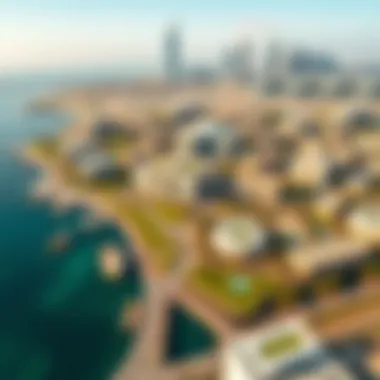Yas Island: A Model for Sustainable Urban Growth


Intro
Yas Island, a marvel nestled in the heart of Abu Dhabi, stands as a beacon of sustainable urban development. Its innovative blueprint crafting a green future is a testament to what can be achieved when dedication to eco-friendly principles meets ambitious urban planning. The balance between creating thriving communities and preserving the environment is central to Yas Island’s philosophy.
What sets Yas Island apart? It’s more than just another destination; it blends luxury, leisure, and sustainability seamlessly. From the planning and construction phases to the operational strategies, each step is infused with a commitment to environmental stewardship. This approach lays a foundation for a more sustainable urban lifestyle that many other developments would aspire to emulate.
As we delve deeper into the nuances of Yas Island’s initiatives, we’ll uncover how it’s reshaping perceptions of urban living. For investors and homeowners alike, understanding these principles is crucial not just for making informed decisions but also for fostering a future where sustainable practices thrive alongside urban progress.
Market Insights
Current Trends in Dubai Real Estate
Dubai's real estate market is nothing short of dynamic, constantly adapting to both global trends and local demands. Yas Island contributes to this vibrant landscape with its unique offerings, attracting investors keen on sustainability.
Developments are commencing to prioritize sustainability over mere aesthetics. Eco-friendly architecture and energy-efficient systems are not just trending; they have become essential criteria for discerning buyers and investors. Green buildings on Yas Island are increasingly sought after, as both residential and commercial spaces integrate innovative technologies that reduce environmental footprints.
Developers here leverage renewable energy sources, utilize environmentally friendly materials, and employ water conservation techniques, underlining a shift towards responsible real estate practices.
Economic Factors Affecting Property Prices
The economic landscape influences Yas Island’s thriving property market remarkably. Several factors are at play, including global economic shifts, demand for sustainable living, and Abu Dhabi’s ongoing investment in infrastructure.
- Rising Demand for Eco-Friendly Properties: Homebuyers are increasingly prioritizing sustainable features in their property searches.
- Government Support: The UAE government's commitment to environmental sustainability is underscored by support for green initiatives, affecting investment attractiveness.
- Infrastructure Improvements: With constant enhancements to transportation and community amenities, property valuations are witnessing upward trends.
In short, the real estate scene in Yas Island illustrates how sustainability and economic viability can coexist, providing an inviting atmosphere for potential investors and residents alike.
Understanding Yas Island
Yas Island has emerged as a leading example of how modern urban development can align with sustainable practices. Understanding the foundational elements of this unique locale is crucial for grasping the breadth of its innovations and advancements in sustainability. To fully appreciate Yas Island's offerings, it’s important to navigate through its geography, historical roots, and current demographics, as these factors not only shape the physical and social landscapes but also influence the overall ethos of the island.
Geography and Location
Nestled in the Arabian Gulf, Yas Island is strategically located just a stone's throw away from Abu Dhabi, the capital of the United Arab Emirates. This proximity to a major urban center makes Yas Island an accessible oasis for both residents and visitors. The island spans approximately 25 square kilometers, providing ample space for development while maintaining green zones and natural habitats.
The topography of Yas Island features a mix of sandy beaches, recreational parks, and bustling entertainment hubs, highlighting a balanced approach to land use. Being situated along the coastline gives it a unique marine appeal, boosting activities like water sports and tourism. With the Yas Marina Circuit, home to the Formula One Abu Dhabi Grand Prix, the island has established itself as a prestigious destination that marries thrilling events with stunning scenery.
Historical Context
Understanding the historical context of Yas Island adds depth to its current status. Originally a barren landscape, the island underwent a major transformation in the early 2000s, spearheaded by the Abu Dhabi government and various stakeholders. This transformation marked the beginning of an ambitious vision for creating a vibrant mixed-use development that would attract both locals and tourists.
Over the years, the island has seen a surge in development that encapsulates both modern architectural design and sustainable principles. For instance, the construction of the Yas Marina and Yas Mall not only constructed a vibrant community space but also supported local businesses and etablished a brand identity that resonates well with emerging market trends.
Current Demographics
Today, Yas Island is home to a multicultural population that reflects the UAE's broader societal landscape. With an increasing number of expatriates calling it home, its demographic tapestry is woven from diverse backgrounds, contributing to a rich social fabric. According to recent statistics, the population is projected to grow, further illuminating the island's potential as a living and working environment.
Key characteristics of the current demographics include:
- Expat Community: Comprising a significant portion of residents, expats from all over the world contribute to the island’s cultural richness.
- Young Professionals: The area attracts young professionals, especially those involved in technology, hospitality, and real estate, fostering economic development and innovation.
- Family-Friendly Environment: Yas Island offers many family-oriented amenities, making it an attractive destination for families seeking an engaging community.
In summary, Yas Island serves as a fascinating blend of geographical advantages, a foundation rooted in thoughtful planning and a demographic profile that nourishes a thriving community. Understanding these elements provides critical insight into how Yas Island is pioneering sustainable urban development in the region.
Foundations of Sustainability
Sustainability represents more than a fleeting trend; it's becoming a fundamental aspect of urban living. As cities grapple with the growing pressures from population increase and resource depletion, finding pathways to sustainable development is crucial. Yas Island stands as a paragon of such efforts, showcasing not just how to build, but also how to cultivate environments that support long-term ecological health. The foundations of sustainability serve as the guiding principles that frame the innovative practices employed in Yas Island.
By focusing on sustainable design, urban planners and developers can create resilient communities. This means designing spaces that not only look good on paper, but also enhance the quality of life for residents and lessen environmental impact. The emphasis is placed not just on aesthetics but on function and sustainability—ensuring that urban developments can withstand environmental pressures without compromising the needs of future generations.
Defining Sustainability in Urban Development
Sustainability in urban development refers to designing cities and communities in a way that integrates economic, social, and environmental factors. This multidimensional approach is essential because it fosters a balance between the demands of urbanization and the intrinsic value of nature. For instance, Yas Island's development prioritizes harmony with natural ecosystems, incorporating greenery and open spaces into urban planning. This integration improves air quality, enhances biodiversity, and promotes overall health among residents.
In more practical terms, defining sustainability in this context involves adopting practices that use resources efficiently. From energy-efficient buildings to smart waste management systems, every element of urban development contributes to a more sustainable future. For example, Yas Island has implemented modern technologies that track energy usage and optimize it, allowing both residential and commercial units to function at peak efficiency, minimizing unnecessary waste. Such initiatives illustrate a commitment to creating spaces that will endure environmentally while supporting vibrant communities.
Key Principles of Sustainable Design
When discussing sustainable design, several key principles often emerge. Each principle plays a critical role in shaping urban landscapes that don’t drain the earth’s resources. These principles include:


- Resource Efficiency: Maximizing the use of renewable materials and minimizing waste is essential. Yas Island emphasizes using local materials, reducing transportation emissions, and supporting the local economy by sourcing labor locally.
- Adaptability: Structures on Yas Island are designed not just for current use but also with future adaptation in mind. This flexibility allows them to evolve as needs change, contributing to a sustained use of space.
- Biophilic Design: By incorporating elements of nature into urban spaces—like plants, water features, and natural light—developers can enhance the well-being of residents. This approach has been instrumental in Yas Island’s development.
- Community-Centric Spaces: Creating public spaces that encourage interaction among residents is vital. Such spaces promote community bonds and are essential for social sustainability. Yas Island boasts parks and recreational areas that not only serve ecological purposes but also offer a gathering space for the community.
Global Trends in Urban Sustainability
The quest for sustainable urban development is not isolated to Yas Island; it reflects a wider global trend where cities are prioritizing sustainability in their growth agendas. Key trends include:
- Smart Technology: The integration of IoT (Internet of Things) in city infrastructure allows for better management of resources. Examples are smart grids and real-time monitoring of resource consumption, making cities like Yas a part of the Smart City movement.
- Green Certifications: Many cities are now encouraging or mandating green building certifications. Yas Island’s properties often aim for Platinum or Gold LEED certification, ensuring they meet high environmental standards.
- Increased Public Transit Options: Cities worldwide are focusing on reducing reliance on personal vehicles. Yas Island has developed a robust public transit system aimed at connecting residents seamlessly, thereby limiting car dependency.
- Circular Economies: This approach focuses on recycling and upcycling materials within the city to minimize waste. Yas Island’s strategies include waste-to-energy plants and extensive recycling programs promoting circular economic practices.
In implementing these trends, Yas Island not only fits into a larger global movement towards sustainability but also positions itself as a driving force and innovative leader in creating livable, resilient urban spaces.
"Sustainability is not a luxury. It is essential. It’s about creating a place where future generations can thrive alongside us" — Yas Island Urban Development Team.
Yas Island: A Model of Sustainable Practices
Yas Island has crafted a path that takes sustainable urban development to heart, establishing itself as a shining beacon of eco-conscious living. As urban areas grapple with issues such as climate change and limited resources, Yas Island offers a compelling case for how sustainable practices can integrate seamlessly into everyday life. The very essence of this model lies in its commitment to creating a balanced ecosystem—one that meets the needs of today without jeopardizing the well-being of future generations.
Promoting green initiatives and sustainable living spaces, Yas Island demonstrates how urban planners can tackle the dual challenge of growth and conservation. The focus on sustainability not only enhances the quality of life for residents, but also offers tangible benefits for investors looking for long-term value. This section will delve into the specific practices that underline Yas Island's sustainable approach, detailing how they translate into advantages for both the community and the wider environment.
Green Architecture
At the intersection of form and function lies the concept of green architecture, a principle that Yas Island embraces wholeheartedly. Buildings here are designed not only to captivate the eye but also to minimize their environmental footprint. Utilizing materials that are sourced sustainably and implementing designs that promote natural ventilation, Yas Island's architecture reflects modern sensibilities geared toward sustainability.
Additionally, elements like green roofs and living walls are not just aesthetic choices; they act as natural insulation, improving energy efficiency while fostering biodiversity. For instance, the Yas Marina Circuit’s structure incorporates these features, allowing for both better thermal control and improved air quality around the premises. The result is an environment that doesn’t merely prevent harm but actively contributes to ecological balance.
"Green architecture represents a necessary shift in our approach to building design—when we prioritize the planet, we enhance the livability for all."
Energy Efficiency Initiatives
Energy is often dubbed the lifeblood of urban development, and at Yas Island, there’s a palpable commitment to transforming how energy is consumed. A cornerstone of its sustainable strategy revolves around energy efficiency initiatives that cut down on energy waste.
From the implementation of solar panels across various facilities to smart grid systems that optimize energy distribution, Yas Island stands at the forefront of energy innovation. These systems allow real-time adjustments to energy use, ensuring that excess is minimized and operating costs are kept in check. Moreover, buildings are outfitted with energy-efficient appliances and retrofitted for better insulation, all contributing to a marked reduction in energy consumption while bolstering the island's economic health.
Water Conservation Strategies
In a world where water scarcity is an increasingly pressing issue, Yas Island’s approach to water conservation is particularly noteworthy. The island employs several strategies to ensure that water resources are utilized judiciously and sustainably.
Rainwater harvesting systems collect precious natural precipitation, turning it into a resource rather than letting it evaporate or run off. Furthermore, greywater recycling techniques are implemented, allowing for the repurposing of water from activities like bathing and laundry for irrigation and toilet flushing.
Landscaping is designed with drought-resistant vegetation, reducing the overall need for irrigation. This comprehensive outlook toward water use not only lessens environmental impact but also promotes responsible consumption among residents, embedding eco-friendly habits into daily lives.
Through these sustainable practices, Yas Island embodies a model of environmental stewardship that others can emulate. The essential principles of green architecture, energy efficiency, and water conservation embody the holistic approach taken to ensure that sustainability isn’t a mere afterthought but a foundational element of urban life.
Transportation and Connectivity
Transportation and connectivity are critical elements in any urban development plan, defining not only how residents move within their community but also how they interact with the larger region. In the context of Yas Island, these factors have been meticulously designed to ensure both eco-friendliness and practicality. A thoughtfully structured transportation network can enhance the quality of life for residents while also enticing potential investors. The seamless integration of various modes of transport contributes to reducing carbon footprints and promotes a sustainable living environment.
Public Transit Solutions
Public transit is the backbone of sustainable urban mobility. Yas Island has implemented various public transport solutions that not only cater to the day-to-day needs of residents but also encourage them to use greener modes of transportation.
- Buses and Shuttles: An extensive bus network connects various attractions and residential areas, minimizing the need for personal vehicles. Buses operate on environmentally friendly fuel, limiting harmful emissions. The frequency and coverage ensure that waiting times are minimal, allowing easy access across the island.
- Water Transit: Yas Island leverages its surrounding waterways by offering ferry services. This alternative not only reduces road congestion but also provides scenic transport routes, enhancing the resident experience.
"Investing in public transit is crucial for sustainable development – it fosters interconnectivity while promoting an eco-conscious lifestyle.”
Cycling and Walking Infrastructure
The introduction of cycling and walking infrastructure is a significant asset to Yas Island's transportation ecosystem. The design encourages a culture of physical activity while decreasing reliance on motorized transport.
- Bike Lanes: Dedicated cycling lanes are strategically placed throughout the island. These lanes are wide enough to accommodate both cyclists and electric scooters, ensuring safety and encouraging mobility among the community.
- Pedestrian Pathways: Concrete walkways and sidewalks are extensive, connecting residential areas with commercial zones and parks. Rest areas and green spots provide places for residents to take a break or enjoy the outdoors while walking.
Long-term benefits of such infrastructure are myriad. Not only do they enhance the community's health by encouraging more exercise, but they also contribute positively to reducing air pollution.
Integration with Smart Mobility
In a rapidly advancing technological landscape, integrating smart mobility solutions is vital for Yas Island to remain competitive and sustainable.
- Smart Transit Apps: Mobile applications provide up-to-the-minute information on public transit schedules and availability. Users can plan their trips efficiently, reducing idle time and enhancing convenience.
- Real-Time Monitoring: Sensors and cameras strategically placed throughout the island monitor traffic flow and public transit utilization. This data helps city planners to optimize routes and schedules based on real user patterns, ensuring that resources are effectively allocated.
- Electric Vehicle Charging Stations: A network of electric vehicle charging stations has been established, making it convenient for residents to opt for eco-friendly vehicles. This initiative highlights the island's commitment to supporting sustainable transport options.
Community Engagement and Education


Community engagement and education are at the very heart of sustainable urban development on Yas Island. These elements not only foster a sense of belonging among residents but also encourage them to actively participate in preserving their environment. By focusing on education and community-driven involvement, Yas Island is setting a benchmark for other urban developments aiming to achieve sustainability. Here’s how these components unfold:
Promoting Eco-Conscious Lifestyles
Eco-conscious lifestyles are essential for sustainable living. Yas Island does not just want its residents to live in eco-friendly spaces; it aims to cultivate a community that understands the impact of their choices. Initiatives such as local farmers' markets, workshops on composting, and community gardening events help draw attention to environmentally friendly practices. Residents engage not just with each other but also with the broader principles of sustainability.
"An informed community is an empowered community."
This approach goes beyond traditional sustainability. It encourages residents to see their daily choices—like reducing plastic use or spoting energy-efficient appliances—as vital contributions to a larger goal.
- Workshops on reducing energy consumption
- Educational campaigns on water conservation
- Challenges to encourage waste reduction within households
These activities are designed to make eco-friendly living an integral part of daily life on Yas Island. Additionally, the island has harnessed social media platforms to amplify these messages, reaching more residents and creating a vibrant community around sustainability.
Resident Participation in Sustainability Programs
The engagement of residents in sustainability programs is crucial. Yas Island actively seeks input from its community when designing and implementing these programs. By involving residents in decision-making processes, such as conducting feedback sessions on new initiatives, the island ensures that the sustainability measures address real concerns. Residents volunteer for projects to plant trees, maintain parks, and contribute to clean-up drives, which have dual benefits: improving the natural environment and strengthening community bonds.
- Collaborative projects led by local organizations
- Monthly clean-up and tree-planting days
- Incentive programs for residents who reduce waste
Participation in these activities fosters ownership and accountability among residents. They are not just passive recipients of information; they actively shape their community's environmental landscape. The sense of fulfilment derived from seeing their hard work translate into tangible environmental improvements further enhances community spirit.
Educational Initiatives for All Ages
Education is a powerful tool for driving sustainable practices. Yas Island has developed educational initiatives aimed at individuals across all age groups. By doing so, it ensures that sustainability becomes part of the community's cultural fabric.
- For Children: Schools on Yas Island include sustainability topics within their curricula, teaching young minds about biodiversity, waste management, and renewable energy sources.
- For Adults: Workshops are tailored for grown-ups, encompassing practical skills like home energy audits and water-saving techniques. Continuous adult learning opportunities allow older residents to stay informed about emerging sustainability technologies.
- For Seniors: Programs specifically designed for older community members focus on health benefits from green living, encouraging them to embrace an eco-friendly lifestyle.
Every initiative aims to empower the community with knowledge and skills, allowing them to advocate for further improvements in their urban environment. This comprehensive educational approach ensures that sustainability remains a living, breathing principle for every resident on Yas Island.
Through community engagement and education, Yas Island illustrates an effective model for other urban developments. By intertwining the community's needs with sustainability goals, it sets a high standard while nurturing a vested interest among residents to protect and enhance their unique environment.
Economic Implications of Sustainable Development
Sustainable development has become a cornerstone for urban planning, especially in innovative environments like Yas Island. The economic implications of sustainable initiatives extend beyond mere investments or property values; they intertwine with social equity, environmental health, and the overall resilience of a community. Understanding these implications can provide investors, homeowners, and urban planners with valuable insights into the growing importance of sustainability in economic models.
Investing in Sustainable Properties
In recent years, the emphasis has shifted towards acquiring properties that not only promise profitability but also adhere to sustainable principles. Investing in sustainable properties on Yas Island offers a myriad of advantages.
- Market Demand: There's a noticeable increase in buyers prioritizing eco-friendly living. Properties designed with sustainable materials often have a competitive edge.
- Regulatory Incentives: Government policies favoring sustainable developments often come with tax breaks or grants, enhancing the financial attractiveness of such investments.
- Resilience to Market Fluctuations: Sustainable buildings often come equipped with energy-efficient systems, which can lead to reduced operating costs and increased durability, safeguarding investors against economic downturns.
One cannot overlook that the initial investment can be higher for sustainable properties, however, the long-term benefits significantly overshadow these costs for astute investors willing to take the leap.
Long-term Value of Sustainable Initiatives
Long-term value is another crucial aspect that links sustainability with economic benefits. Investments in sustainable infrastructure on Yas Island not only elevate property values but also contribute positively to the community’s economic standing over time. This merits attention:
- Increased Property Values: Properties that incorporate sustainable features often appreciate faster than traditional buildings. For instance, integrating solar energy can lead to reduced utility bills, increasing attractiveness to future buyers.
- Job Creation: Sustainable initiatives foster job growth in various sectors, from construction to green technology, ensuring that the local economy flourishes.
- Attractiveness to Investors: As awareness of climate change grows, many investors seek portfolios that include sustainable assets. This demand underlines the tangible financial viability of eco-conscious developments.
Having noted that, sustainability initiatives pave the way for a resilient economy, with robust returns that appeal not just to environmental advocates but also to traditional investors.
Attracting Eco-friendly Tourism
Yas Island has positioned itself as a magnet for eco-tourism, demonstrating that sustainable development can create a thriving sector that contributes to the economic landscape. This growth can be attributed to several factors:
- Unique Selling Proposition: Eco-friendly resorts and attractions provide a distinctive experience drawing in tourists who prioritize sustainability. This unique appeal enhances the island's attractiveness.
- Increased Visitor Spending: Tourists are often willing to spend more on experiences that are both enjoyable and environmentally conscious, generating a boost in local businesses.
- Community Involvement: When tourists engage in local sustainable practices, it fosters a deeper connection, benefiting both visitors and residents alike.
Investing in eco-friendly tourism not only amplifies Yas Island's appeal but also secures economic resilience for the community. By focusing on sustainability, the island can advance economically while preserving its unique environment for future generations.
"A sustainable approach in urban development transforms challenges into opportunities, ensuring longevity in both nature and economy."
Sustainable Living: Residents’ Perspectives
Sustainable living on Yas Island is much more than just a trend; it's a way of life that influences every resident's day-to-day decisions. With a focused approach towards sustainable urban development, this island has redefined what it means to live in harmony with nature while still enjoying the comforts of modern amenities. The importance of examining residents' perspectives lies in understanding how these eco-friendly initiatives truly impact their lives and the overall community. Each initiative designed with sustainability in mind has multiple facets that lead to tangible benefits, significant challenges, and future aspirations.
Benefits of Sustainable Living


Living sustainably on Yas Island brings a multitude of advantages that resonate deeply with residents. Here are some key benefits:
- Reduced Utility Bills: With energy efficiency initiatives, residents often find their monthly energy costs are significantly lower compared to conventional living models.
- Healthier Lifestyle: Access to green spaces, pedestrian pathways, and cycling tracks fosters a healthier lifestyle, encouraging physical activity and reducing reliance on vehicles.
- Enhanced Quality of Life: Clean air and minimized pollution contribute to a higher quality of life, promoting well-being among residents.
- Community Bonding: Sustainable living encourages community engagement, leading to stronger bonds among residents as they participate in green initiatives together.
- Increased Property Values: Property in sustainable developments tends to maintain better market values, appealing to eco-conscious investors and homebuyers.
These benefits collectively illustrate how adopting sustainable practices enhances the daily routine of the residents on Yas Island, fostering a thriving community centered around eco-conscious thinking.
Challenges and Considerations
While sustainable living offers several benefits, residents face challenges in this endeavor. Understanding these issues is crucial for real estate investors and community planners alike. Some challenges include:
- Initial Costs: The upfront investment for eco-friendly technologies and sustainable homes can be substantial, possibly deterring some prospective residents.
- Behavioral Adaptation: Transitioning to a sustainable lifestyle requires a behavioral shift that not everyone may be willing to embrace.
- Maintenance of Green Spaces: Ensuring that parks and natural habitats are well-maintained can be labor-intensive and costly, necessitating ongoing community effort.
- Limited Infrastructure: Some residents may feel that existing public infrastructure is insufficient to support their sustainability goals, particularly in public transportation.
- Balancing Development with Sustainability: The dynamic between expanding community services and maintaining green initiatives can sometimes lead to conflict among stakeholders.
Awareness of these challenges is essential for understanding the holistic picture of sustainable living on Yas Island. Without addressing them, any benefits that arise from sustainable practices might be undermined.
Future Aspirations for Residents
The vision for sustainable living on Yas Island is not static; it evolves as the community grows and adapts. Here are some aspirations that residents hold for the future:
- Increased Involvement in Sustainability Programs: Many residents express a desire for more opportunities to participate in eco-friendly initiatives that impact their community directly.
- Expansion of Renewable Energy Sources: Future developments might include an increased reliance on solar and wind energy to further decrease utility costs and carbon footprints.
- Enhanced Public Transportation Options: The hope is for improved public transport accessibility, making it easier for residents to reduce their dependence on personal vehicles.
- Sustainable Food Systems: There is an aspiration to establish community gardens and urban farms that can support local food production and enhance food security.
- Continuous Educational Opportunities: Residents desire ongoing education about sustainable practices, which will ensure that they remain informed and engaged in environmental stewardship.
In essence, the future aspirations of Yas Island’s residents reflect a community that not only values sustainability but is eager to expand upon it. With a proactive mindset, they are set to elevate this model of sustainable urban living for years to come.
"The journey toward sustainability isn't just a personal choice but a collective effort that reshapes how we live, work, and interact with our environment."
As Yas Island continues to pave the way in sustainable urbanism, understanding residents' perspectives forms an essential piece of this complex puzzle, one that investors and planners must consider to foster a truly thriving community.
Innovations and Future Developments
Yas Island stands as a showcase for the evolving narrative of sustainable urban development. In an era where climate change and urbanization present unique challenges, the focus on innovations and future developments becomes critical. Embracing cutting-edge technologies and forward-thinking projects, Yas Island exemplifies how urban landscapes can pivot towards sustainability while enhancing the quality of life for residents and visitors alike. This commitment not only breathes new life into the urban fabric but also paves the way for scalable models that can be replicated in other places.
Emerging Technologies in Urban Sustainability
The landscape of urban sustainability is rapidly shifting, driven by advancements in technology. Emerging technologies play a pivotal role in this transformation. For instance, smart grid systems enable better energy management by optimizing electricity use based on real-time data. Another promising innovation is the utilization of artificial intelligence in urban planning; AI can analyze vast amounts of data to predict traffic patterns, helping to minimize congestion and reduce emissions.
Furthermore, integrating renewable energy sources like solar panels into residential and commercial buildings has proven invaluable. Innovations such as building-integrated photovoltaics can seamlessly combine aesthetics with functionality, ensuring structures not only meet energy standards but also enhance the visual environment of Yas Island. With the commitment to eco-friendly practices, every new technology adopted represents not just a step forward for Yas Island, but a scaling of ambition for cities globally.
"It’s no longer enough to build; we must build responsibly and intelligently."
— Urban Development Advocate
Future Projects on Yas Island
Looking ahead, Yas Island is embarking on a range of future projects that encapsulate its vision of a sustainable urban utopia. One notable initiative is the Yas Eco Park, aimed at showcasing native flora and fauna, educating visitors on biodiversity, and promoting conservation efforts. Such projects not only enhance ecological resilience but also engage the community in preservation efforts.
Additional developments are focused on enhancing green spaces throughout the island. The Yas Island Green Network will weave together parks, gardens, and recreational areas with the urban fabric, fostering healthier living environments. Integrating these spaces into the daily lives of residents is critical in cultivating a sense of community and well-being, reinforcing sustainability as a lifestyle choice.
Vision for a Sustainable Urban Future
The ultimate vision for a sustainable urban future at Yas Island reflects a holistic approach—intersecting economic growth, environmental responsibility, and social equity. This vision emphasizes a circular economy, where waste is minimized, and resources are continually repurposed. By implementing systems that prioritize sustainability, Yas Island stands at the forefront of a global movement toward resilience and adaptability in urban environments.
The commitment to innovation extends beyond technology; it calls for a shift in mindset among investors and residents alike. Aspiring to create spaces that inspire community interactions, promote sustainable practices, and facilitate an eco-conscious lifestyle is essential for holistic success. The roadmap for Yas Island not only demonstrates sustainable urbanism in action but also poses critical questions for the future of cities worldwide: How can we innovate responsibly? What role should community play in this evolving landscape? These inquiries will guide the future as Yas Island continues to set the pace in pioneering sustainable urbanism.
Closure: Yas Island’s Impact on Sustainable Urbanism
Yas Island has emerged as a blueprint for sustainable urbanism, showcasing how thoughtful planning and innovative designs can pave the way for greener cities. Its journey presents a unique example of both commitment and adaptability, demonstrating how sustainability can be woven into the fabric of urban living. The significance of Yas Island lies not just in its physical attributes but also in the mindset it cultivates in both residents and policymakers.
Summary of Key Insights
Through its multifaceted approach, Yas Island illustrates several crucial insights into sustainable development:
- Integration of Nature and Urban Life: The island harmoniously blends residential, commercial, and recreational spaces with abundant green landscapes. The effectiveness of this integration reveals how we can live alongside nature instead of in opposition to it.
- Community-centric Initiatives: Sustainable urbanism is as much about the people as it is about the infrastructure. Yas Island’s active recruitment of resident involvement in eco-friendly programs has fostered a strong sense of community and ownership.
- Applicability of Technology: The use of current technologies for energy efficiency and smart mobility on Yas Island reflects a forward-thinking mindset. Emphasizing that technology isn’t merely a tool but a partner in promoting sustainability underscores a critical shift in urban living.
"Yas Island proves that sustainable urbanism isn’t just a dream but a reality that others can aspire to achieve."
Lessons for Other Urban Developments
Yas Island's rich tapestry of sustainable features has garnered attention beyond its borders. Here are vital takeaways for cities aiming to harness the essence of sustainable development:
- Prioritize Green Spaces: Urban planners should prioritize parks, gardens, and recreational areas that promote biodiversity while offering residents a refuge from concrete. Greenery is not just aesthetic; it serves an essential environmental function.
- Foster Resident Participation: Encourage community participation in sustainability initiatives. Programs that involve residents can lead to deeper commitment and better results, as seen on Yas Island.
- Embrace Technology: The integration of technology in urban planning can streamline energy use, transportation systems, and waste management. Cities should seek innovative technological solutions without losing sight of the human element.
Looking Ahead: The Future of Sustainable Cities
The future of urban development may well be shaped by the principles demonstrated at Yas Island. As cities worldwide strive to reduce their carbon footprint, the following aspects could very likely play a pivotal role:
- Collaboration Across Sectors: As the line between public, private, and civic responsibilities blur, collaborations can yield innovative solutions. Public-private partnerships are essential for funding and managing sustainable initiatives.
- Adaptability to Climate Change: Cities must focus not just on currently pressing issues but also on adapting to future environmental challenges, such as rising sea levels and extreme weather. Yas Island’s approach offers a model to navigate these forthcoming hurdles.
- A Global Perspective: Sustainable urbanism isn't isolated. As cities face similar challenges, sharing insights and strategies facilitates a global approach to improving urban living. Yas Island stands as a testament to what can be achieved when different entities work together.
As cities continue to grow and evolve, Yas Island serves as a guiding force. By emphasizing sustainability, we are not just enhancing the current environment but also ensuring that future generations inherit a land where urban and natural ecosystems thrive together.











